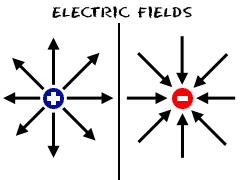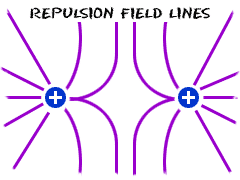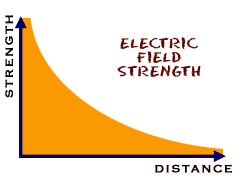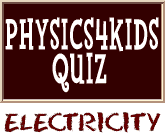Field Basics
 Scientists understood why forces acted the way they did when objects touched. The idea that confused them was forces that acted at a distance without touching. Think of examples such as gravitational force, electric force, and magnetic force. To help them explain what was happening, they used the idea of "field". They imagined that there was an area around the object, and anything that entered would feel a force. We say, for example, that the Moon has a gravitational field around it, and if you get close to the Moon, it will pull you down to its surface.
Scientists understood why forces acted the way they did when objects touched. The idea that confused them was forces that acted at a distance without touching. Think of examples such as gravitational force, electric force, and magnetic force. To help them explain what was happening, they used the idea of "field". They imagined that there was an area around the object, and anything that entered would feel a force. We say, for example, that the Moon has a gravitational field around it, and if you get close to the Moon, it will pull you down to its surface.
Electric Fields
An electric field describes the funky area near any electrically-charged object. Scientists don’t use the word "funky", but it works. It could also be called an electrostatic field. Any other charge that enters that area will feel a force, and the original object will also feel that force (Newton's Third Law). It's kind of like a spider sitting at the center of a web. A normal field is a vector, and is represented by arrows. The Earth's (or any planet's) gravitational field would be drawn as arrows pointing toward the ground. A field vector shows the direction of the effect on an object entering the field. Gravity acts downward.
A normal field is a vector, and is represented by arrows. The Earth's (or any planet's) gravitational field would be drawn as arrows pointing toward the ground. A field vector shows the direction of the effect on an object entering the field. Gravity acts downward.
For an electric field, things are a little more complicated, since there are two kinds of charges, and some combinations attract while others repel. In order to be in agreement with each other, physicists decided that they would always use positive charges to determine the direction of the effect of a field. So, if the central charge was positive, and you put another positive charge near it, that second charge would be repelled outward. So the field vectors for a central positive charge point outward. If the central charge is negative, a positive charge placed nearby would be attracted toward the center charge, so the field vectors for a central negative charge point inward.
 Since fields are directly related to the forces they exert, their strength decreases with distance, and increases with the size of the charge producing the field. When you put charges near one another, their fields interact and change shape. This results in changes in the PE of the objects, and generates forces of repulsion or attraction.
Since fields are directly related to the forces they exert, their strength decreases with distance, and increases with the size of the charge producing the field. When you put charges near one another, their fields interact and change shape. This results in changes in the PE of the objects, and generates forces of repulsion or attraction.
Electric fields can also be created by magnetic fields. Magnetism and electricity are always connected. We'll talk about magnetic fields in the next section.
Or search the sites for a specific topic.
- Overview
- Charges
- Conductors
- Electric Fields
- Magnetic Fields
- Current
- Resistance
- Faraday's Law
- Coulomb's Law
- Magnets
- DC Power
- AC Power
- More Topics

History of Electricity (NASA/WhyFiles Video)

Useful Reference Materials
Encyclopedia.com (Electromagnetic Field):http://www.encyclopedia.com/topic/Electromagnetic_fields.aspx
Encyclopedia.com (Induction):
http://www.encyclopedia.com/topic/induction.aspx
Wikipedia:
http://en.wikipedia.org/wiki/Electric_field
Encyclopædia Britannica:
http://www.britannica.com/EBchecked/topic/182554/electric-field





